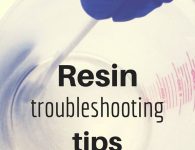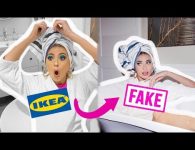
Episode 84, August 7, 2019
Dr. Nathalie Riche envisions a future in which all of our data will be accessible, meaningful, compelling and artistic. And as a researcher in human computer interaction and information visualization at Microsoft Research, she’s working on technical tools that will help us wrangle our data, extract knowledge from it, and communicate with it in a memorable, persuasive and aesthetically pleasing way. In other words, she wants our data to be both smart… and beautiful!
Today, Dr. Riche shares her passion for the art of data driven storytelling, reveals the two superpowers of data visualization, gives us an inside look at some innovative projects designed to help us th(ink) with digital ink, and tells the story of how a young woman with an artist’s heart headed into computer science, took a detour to the beach, paid for it with research and ended up with a rewarding career that brings both art and computing together.
Related:
- Microsoft Research Podcast: View more podcasts on Microsoft.com
- iTunes: Subscribe and listen to new podcasts each week on iTunes
- Email: Subscribe and listen by email
- Android: Subscribe and listen on Android
- Spotify: Listen on Spotify
- RSS feed
- Microsoft Research Newsletter: Sign up to receive the latest news from Microsoft Research
Transcript
Nathalie Riche: DataInk made me realize how expressive the pen can be. And when I was thinking about this project, I was like, I don’t have to think when I use the pen. It’s just like, you know, I’m just expressing myself and I don’t have to think about how am I going to do it? It’s just so natural for me. I just put my pen down and then that’s the way it goes. And so, how cool would it be if, you know, I could use this for just expressing my thinking all the time?
Host: You’re listening to the Microsoft Research Podcast, a show that brings you closer to the cutting-edge of technology research and the scientists behind it. I’m your host, Gretchen Huizinga.
Host: Dr. Nathalie Riche envisions a future in which all of our data will be accessible, meaningful, compelling and artistic. And as a researcher in human computer interaction and information visualization at Microsoft Research, she’s working on technical tools that will help us wrangle our data, extract knowledge from it, and communicate with it in a memorable, persuasive and aesthetically pleasing way. In other words, she wants our data to be both smart… and beautiful!
Today, Dr. Riche shares her passion for the art of data driven storytelling, reveals the two superpowers of data visualization, gives us an inside look at some innovative projects designed to help us th(ink) with digital ink, and tells the story of how a young woman with an artist’s heart headed into computer science, took a detour to the beach, paid for it with research and ended up with a rewarding career that brings both art and computing together. That and much more on this episode of the Microsoft Research Podcast.
(music plays)
Host: Nathalie Riche, welcome to the podcast!
Nathalie Riche: Bonjour!
Host: Bonjour! I like to start my podcasts by situating my guests and their research. So, let’s situate you. You conduct research in the field of data visualization. In broad strokes, tell us what problems are you trying to solve, what questions are you asking, what gets you up in the morning?
Nathalie Riche: I guess what gets me up in the morning is to be able to create visuals from data that actually can be useful to a lot of people. And you know, everyone has data, whether it’s like personal or at work. So, that’s sort of this unique opportunity to try to leverage that and then help people use that data, right, to gain knowledge and insights. And what really gets me up in the morning is this creativity part. Because I have this data that’s really like you know ugly in some ways and I have to make it sort of inspiring and rich of insight and synthesize it. So, I have to craft sort of art from that data that could be also hard that is, you know, useful and like touching people. It’s really akin to art, right? It’s like how do you extract the message, and how you best communicate it? And people are just very receptive to things that are beautiful, right, and that touch you emotionally, or just simply like, you know, stop you and make you look at it.
Host: Let’s talk a second about EPIC, or Extended Perception Interaction and Cognition, “the group.” It’s a thing here. I’ve had a few of your colleagues on the podcast already and your work falls under the larger umbrella of Human Computer Interaction, or HCI. But you follow specific lines of research within that, on smaller groups or teams, and EPIC is one of those. So, why this particular group? What does your team bring to the HCI table?
Nathalie Riche: Mmm-hmm! We do EPIC research!
Host: Of course you do!
Nathalie Riche: Well so, first, I really love our group. Our group is very diverse. We don’t really, like, focus on one specific device. But what we care about is the experience. So, from end-to-end experience. For example, I care about inking. So, what do people do with a digital pen in their actual day-to-day job, or life? And so, we do care about the breadth of the activity and not just one particular domain or type of audience or task. What I really care about these days is how do you help people think with this digital ink?
Host: Ohhh.
Nathalie Riche: Because I think with ink all the time, right, with pen and paper, on my whiteboard, and so on. So how can I really support this broad activity, right? Like, what do people do when they are thinking and how can we help them think with their device that has this pen?
Host: Right. You know, drilling in just a little bit there, I write a lot for my job.
Nathalie Riche: Mmm-hmm.
Host: And I think on a whiteboard, and I have notebooks all over the house, in fact, half-filled notebooks… But I feel like there’s a connection there that I don’t have right now with any of my digital devices.
Nathalie Riche: Well, in fact, that’s what we try to bring to the table in lots of our projects, like the recent projects we’re doing. You know, somehow, we don’t have that connection with digital ink. But yet digital ink can do crazy things for you because it knows like everything is in the computer. So, could you imagine if you start writing down some notes and then it brings you back three of those ideas you had in those half notebooks all over the place. That’s like this unique superpower.
Host: Sure.
Nathalie Riche: So that’s the sort of things we want to try to leverage, bring that connection, but then also the power of the computer.
Host: Speaking of superpowers, you have said, famously, to some degree, that data visualization has two superpowers. Okay, what are they?
Nathalie Riche: Yeah.
Host: And why are they super?
Nathalie Riche: Obviously, I have young kids and they love superheroes, so… so I just give superpowers to everything in my life. So, yeah, data visualization has two superpowers. The first one, it’s about identifying insights. And the way visualization does this is by basically answering questions you didn’t even know you had about your data. So, you just look at it, and it’s a bit like looking at the clouds in the sky and then you see patterns. And it’s not really that you were thinking about those patterns, right? It’s very different from, like, running an analysis test, but it’s more about something you are noticing and that basically it generates questions in your mind. And then that’s like, you know, this making you see through some of that data. So that was about the exploration, right, and like, sort of, learning from your data…
Host: Yeah.
Nathalie Riche: …and identifying things. The second one is about communication. So, a picture is worth a thousand words, right? And, when you see the picture, a lot of that superpower that the visual has is just directly going through your sensory system. That’s what we call pre-attentive. You are not even aware…
Host: Interesting.
Nathalie Riche: …that it’s like happening in your brain. And so, you are perceiving that message extremely fast. And so that’s like this superpower of communication that is, you know, much faster than verbal or, like, textual. And so that’s the superpower of communication.
Host: As a researcher, you’ve made it clear that you are not a data scientist. Rather you work on building tools that data scientists will be using. And we can extract from that, to some degree, that that means you have to predict the future. So, tell us about your thought process as you seek to equip the next generation data scientists with tools for jobs that maybe haven’t even been invented yet? I don’t know, no pressure.
Nathalie Riche: So, first, you know, I do think about data scientists like, as we know them today, which helps.
Host: Yeah.
Nathalie Riche: And I see a lot of them struggle. But I do think about, you know, the future in which every one of us is going to be a data scientist because, you know, we’re going to have even more access to data and we’re going to have to make decisions from it. So, the tools I’m sort of thinking are more and more designed towards helping anyone deal with their data and like leveraging those two superpowers. So, sort of the way I predict the future is relying a lot of my own experiences, what I can learn, what I can do. I’m sort of the “super” data scientist, right?
Host: Yeah.
Nathalie Riche: Because I’m the user of my own tools that I haven’t done yet. So, sort of trying to rely on my own experience, and then other people’s experience, and so I spend a lot of time observing people and like, you know, watching them work and then trying to sort of extract what are the key activities that they are doing that we really don’t support right now and then trying to build tools to help support those.
Host: Let’s talk about the data scientist for a second, because that’s your kind of target audience even though it has broader application. What do they say to you when you talk to them, sort of upstream in your research, about the kinds of problems they’re facing, what they wish they had, and what they wish they could do?
Nathalie Riche: Right. So, a lot of the problems led to a lot of the research that I’ve done like in the past five years which is a lot of data scientists, they are very good at what they are doing. So, they are very good at, basically, getting into the data and then, like, kind of massaging it and then extract those insights from it.
Host: Sure.
Nathalie Riche: But one of their key struggles is to actually transform that insight into some communication that they need to do to their upper-management or, you know, to other people that aren’t really that familiar with the data or with the method.
Host: Or technically sophisticated.
Nathalie Riche: Exactly. And, you know, you need to have this good sense of design.
Host: Mmm-hmm.
Nathalie Riche: And a lot of data scientists, although some are really amazing, still they had some issues like, you know, crafting aesthetically pleasing charts or even memorable ones.
Host: Mmm-hmm.
Nathalie Riche: And so, a lot of this that’s sort of like the activity we call storytelling.
Host: Yeah.
Nathalie Riche: And so, a lot of the struggle was about, you know, once you have the data and then you have the insights, how do I sequence it and message it and so that I have actually a story…
Host: Right.
Nathalie Riche: …with visuals out of all of that masses of data and charts that I’ve created.
Host: Well since you mentioned storytelling, I want to wade upstream before we get specific and talk about this big idea of data-driven storytelling. You have a lot of research projects going on in this space. But before we get granular, give us a sort of “raison d’etre,” if you will, for data-driven storytelling.
Nathalie Riche: So, storytelling, you know, it’s been there forever, right? I mean, that’s the way humans communicated before they knew how to write.
Host: Right.
Nathalie Riche: And in fact, a lot of them drew. And so, we sort of kept this going on, right? And that’s one of the best ways to convince people and try to convince them to make decisions and so storytelling is really this notion that you can take this person with you along the path of your reasoning so that that person can see your argument and understand it and hopefully, you know, agree with you all the way…
Host: Yeah.
Nathalie Riche: …until you can make your point. And so, what’s really the point of the storytelling is to demonstrate your point you are making there, substantiated by data. It’s not just like you know out of my own brain…
Host: Right.
Nathalie Riche: …but it’s like data that I’ve collected so that it’s somewhat more objective than my own opinion. And so, there is an art to it, right? You need to have the story, but you also need to show that this is coming from the data you’ve collected. So, that’s where it’s become very difficult because you have to link that data and the objective facts, then weave them into a story that is logical and a progression, and that people can, you know, come along with you and then understand each step on the way. And then be able to sort of agree or disagree or make their decision.
Host: Right. So, it’s interesting that you frame this in terms of persuasion…
Nathalie Riche: Mmm-hmm.
Host: …and you are talking about data and visuals and stories.
Nathalie Riche: Mmm-hmm.
Host: How much emotion is necessary, or finds its way in, in this path?
Nathalie Riche: Ah-ha! That’s the big elephant in the room in the field, because we want to be truthful to the data and objective. But the reality is, you know, emotions have a big impact.
Host: Yeah.
Nathalie Riche: And so, and the visuals can carry a lot of that emotion. But it’s also really hard to measure. In fact, we have a team in HCI that works on this. Mary Czerwinski’s team. But so basically, it’s very hard to quantify, but it has a very strong impact. And so right now it’s like an open research problem.
Host: Well you can’t really extract it because any kind of a visual, a picture, an image that you show, will probably have some kind of an impact on a person looking at it.
Nathalie Riche: Mmm-hmm.
Host: And so, you’re like, we want it to be emotional enough that we can move people along and motivate and persuade…
Nathalie Riche: Mmm-hmm.
Host: …but not so much that it becomes propaganda?
Nathalie Riche: Exactly. And I guess a lot of that is also from the data itself. That’s also hard to control. You know, if I show you data about, like, you know, World War I or World War II, it’s very different from sales in Surface devices.
Host: Right?
Nathalie Riche: Although you know some people at Microsoft might find it more emotional.
Host: It depends on if it was a bad month…
Nathalie Riche: But that is very hard to control. And there is a number of works that start tackling this.
Host: Yeah.
Nathalie Riche: But it’s still very sort of recent…
Host: …research.
Nathalie Riche: …you know. Yeah.
(music plays)
Host: Well let’s get specific and start with a super interesting project called DataToons. This was highlighted in a paper you just presented at CHI this year and it made me want to be a data scientist because I wanted to use it. That’s pretty cool. Tell us about DataToons and what comics, or cartoons, have to do with a very serious field of data science.
Nathalie Riche: Yes. So, when we started to work on storytelling, of course my brain went to stories that I read to my kids and, among those, there’s a lot of those illustrated stories and comics. And so, I sort of stored that in part of my brain and then went on with, you know, the more sort of “serious” storytelling.
Host: We’re making air quotes a lot in here.
Nathalie Riche: But then after a while, I thought we should really leverage this notion of comics because they are very sequential, and they really are good at conveying, you know, like, temporal stories and so this whole line of research started on how we can leverage this genre of storytelling and then make it data driven. And so that’s what we call the data comics. So, we’ve done a lot of research on those data comics. How are they differing from infographics? What sort of design principles we can give people to create those and whether they are effective as a storytelling mechanism? And a lot of those research actually ended up in papers at the CHI conference that you are citing. And then a lot of those papers gave us ideas about a tool that could help you craft those. And that tool is DataToon. And, given the work in our group about pen and touch and all of those devices that we have at Microsoft, we sort of tried to leverage the Surface Studio and then tried to offer this nice pen and touch experience to craft comics from your data. And so basically, what we end up doing is, you load some data set that you have – it could be an Excel spreadsheet, you know, of your finances –
Host: Yeah. Please no…!
Nathalie Riche: – and you basically drag and drop part of it to create panels.
Host: Oh, okay.
Nathalie Riche: And then, as you duplicate panels, and you change the date and time, or like you change the style, or you change, you know, some of the focus of the part of the data you are caring about, you are basically creating this sequence of panels and you lay them out in space, and it becomes a comic. So that’s the idea behind this DataToon.
Host: Where does that live right now? Is it still sort of in research or is this downstream and I could get it if I had a Surface?
Nathalie Riche: It’s in-between.
Host: Somewhere between!
Nathalie Riche: So, it’s online. So, we like to do a lot of our tools like on the web nowadays.
Host: Yeah.
Nathalie Riche: So, it’s website you can just go to.
Host: Okay.
Nathalie Riche: It’s research in the sense that it’s a prototype, so, you know, it doesn’t handle tons of data. And, you know, it’s not really ready for massive usage.
Host: Yeah.
Nathalie Riche: But you can use it with some of your data and then you can craft comics. And the whole idea behind it is really to help the research community and people interested in trying to create comics and then see the sort of comics they could create.
Host: Right.
Nathalie Riche: And then reflect upon those and figuring out the sort of comics that are created whether, you know, people enjoy this medium or not.
Host: Yeah, this work that you are doing is incredibly visual, as if that weren’t obvious from “data visualization,” and here we are in an audio podcast. So, I’m going to encourage our listeners to hit up the Microsoft Research website and go to your page, Nathalie Riche. That’s N-a-t-h-a-l-i-e R-i-c-h-e and look at some of the videos of this work because it’s really cool, the demos that you’ve got showing how it works. And we really can’t convey that.
Nathalie Riche: No.
Host: But you’re doing a good job with words.
Nathalie Riche: Thank you.
Host: So, anyway. Well, creative visual expression, which is kind of what we’re talking about writ large, is always a challenge given that most people can’t draw.
Nathalie Riche: Mmm-hmm.
Host: And most data visualization tools are actually designed for data professionals of one sort or another.
Nathalie Riche: Mmm-hmm.
Host: But your team has developed a tool called DataInk for people who might want to express personal data more beautifully or to a less professional audience. And this is a really cool project because it was inspired by another really cool project called Dear Data. So, give us a bit of the back story on Dear Data and how it informed your work on DataInk and where that lives now.
Nathalie Riche: So, Dear Data is such a fascinating project. Like when I learned about it, my heart burst with love for those people! Um, and basically, Georgia and Stephanie, they are both designers, and one is in New York and one lives London. So, every week they would go about collecting data about their life. So, they would agree ahead of time about what sort of data to collect and then they would collect that data, and then at the end of the week, craft a unique visualization that highlights that data and you know, some insight about that data.
Host: Mmm-hmm.
Nathalie Riche: And then craft this unique and whimsical visualization of their personal data. They would actually draw it on a post card and then send it to each other. And so, they did this every week for a year. So, can you imagine? Like, that’s sort of the dream of any researcher! Because you have all that data plus the visual language. And they were all like beautiful, and they were all very unique. And they each conveyed those emotions about that data. So, this was just so inspiring. And knowing that a lot of those post cards, they are created by very simple shapes. So, you know, you mentioned earlier, like, you don’t know how to sketch or how to draw, but you know how to draw a circle. And you know how to draw an arc. So, a lot of those compositions, they are composed by very simple shapes that anyone can draw. But yet putting them together is like this just unique beautiful art, but it’s also meaningful art, right?
Host: Yeah.
Nathalie Riche: That tells you a story about a little piece of you. And so, when looking at this, we were just so inspired and we thought, that must be such, you know, hard work, first to collect that data, and then to draw it, because they actually did sometimes spend hours just redrawing it. And so, we thought maybe by making it easier, people could benefit from, you know, working with their data and maybe sharing it with others without the dedication required to spend hours drawing on the post card, right? And the other thing is, once you are invested in this one idea, you just go for it because it’s so long, you know, and tedious. So, you can’t really change your mind as you are doing it because it’s so tedious. Like, if you’ve done half of your data, you are like, argh, I’m just skipping this circle! So, we thought also that the digital device could help you sort of change your mind because it will just populate the entire data visualization, you know, if you change your mind from circle to square. Boom, it’s sort of done in a second. So, we developed this tool called DataInk where you can start from a sketch and then you can bind properties of that sketch. So, say the color of the circle, or like the stroke width of the circle to a data property, and basically generate the entire visualization for all of your data.
Host: So, what I’m hearing is that you’ve got the tactile, human interface of pen and touch…
Nathalie Riche: Mmm-hmm.
Host: …and then you have the power of a digital tool underneath that…
Nathalie Riche: So, the computer is basically assisting you, right? So, you sort of give the comment and it just does it to all of your data. So, imagine if you’ve collected, you know, two thousand sleep patterns.
Host: Yeah.
Nathalie Riche: You know, you are deciding about the way you want to include it. So, oh, I’m going to use shades of colors for, like, how long I slept every night. And once you’ve decided about that color palette, then basically you tell the computer, okay, just do it for the two thousand points.
Host: Autofill.
Nathalie Riche: Yes. Autocomplete! That’s it! Yes.
Host: Okay, so we’ve got these threads of DataToons, DataInk… There’s another project I want to talk about which is called ActiveInk. So, when we think about traditional data visualization tools, or even other CAD tools – computer assisted drawing – we think about the classic computer user interface of a mouse, a keyboard and a screen. But it’s much more natural for us to use our hands and pens, via touch. And you have an answer to that, too. Interface innovation galore! It’s ActiveInk. Tell us about ActiveInk and how it changes our preconceptions about “thhh-inking” with ink – thinking with ink!
Nathalie Riche: Ooh.
Host: You do a lot of these wonderful plays on words. It’s just… I love it, as an English major.
Nathalie Riche: So, yeah, in fact, you know, we just talked about DataInk, and DataInk made me realize how expressive the pen can be. And when I was thinking about this project, I was like, I don’t have to think when I use the pen. It’s just like, you know, I’m just expressing myself and I don’t have to think about how am I going to do it? It’s just so natural for me. I just put my pen down and then that’s the way it goes. And so, how cool would it be if, you know, I could use this for just expressing my thinking all the time? And especially when I deal with data, or when I work with documents and maps and spreadsheets, if I could just express what I’m thinking, or like cross-referencing information from one to the other with just my pen. So that’s what ActiveInk is. And basically, the idea of “active” is, you know, when you have everything, imagine you have this big canvass and you have all of your pieces of information that matter. And basically, you start drawing on top of it with your pen, you know, to show connections between them. Basically, the system knows what you’ve drawn on top to, right? It knows the underlying content. So, it can, sort of, transform the rest of the material that you have on your screen. And so that’s basically why we said the ink becomes active. So, you draw something that’s sort of your externalization of your thinking right there, right? And then the system sort of looks at what you’ve circled there and then shows you relevant information. You know, the way we see the ink is sort of a deferred command that you would do to the system. You didn’t yet do the action, but you were going to probably do this. And so, we can actually just boom, remove that friction and that need for you to go and actually do that, we could just do it automatically. So that’s what ActiveInk is about.
Host: Okay. All right. So, we keep referring to the system.
Nathalie Riche: Yes.
Host: Can you unpack that? Is it the internet? Is it data that I’ve already collected? Where does all this information come from, that it knows?
Nathalie Riche: Ah ha-ha. Well the system, especially in my world, it’s all about a web app.
Host: Okay.
Nathalie Riche: So, imagine you go on a URL and then that’s an application there.
Host: All right.
Nathalie Riche: And we always sort of assume that you have a bunch of documents living in the cloud, right? So, we know, because you’ve logged in in some other places like, you know, in your Office 365 account, we sort of know all the documents that you own, or that you can have access to. And imagine, you know, it would be like logging on One Note and just having some special capabilities that we give to the digital ink…
Host: Okay.
Nathalie Riche: …that lives in an app where we sort of know your content and we can retrieve it for you.
Host: Would it incorporate places that I’ve looked on the web in terms of, you know, searching for information and things like that?
Nathalie Riche: Exactly. And so that’s another component. Ha-ha! You… Interesting! You, you’ve just…!
Host: Yeah, little threads everywhere…
Nathalie Riche: Yeah, look at you! Um, but yeah, one thing, for example, that we transfer from pen and paper to active ink in the digital world… so, you know how, when you sort of read, like, documents, you may write a little asterisk someplace, right, like on important information or important paragraph, and then you put this asterisk in some other places and so, like, as a reference or bookmark. So, we sort of do this in ActiveInk. So, when you browse the web, you can circle part of a web page that you are interested in and you could usually refer it with the little symbol or little asterisk. And so, in ActiveInk, then, you can just draw that same shape and like search for similar ones. And so, it can retrieve for you all of the little shapes that were in other pages and then just retrieve that part of the content in the ActiveInk canvas.
Host: Wow.
Nathalie Riche: So, it’s sort of a way to gather information as well, that you’ve visited.
Host: Right. Even if you can’t remember that you visited it, but you might have made a mark on it and it comes back to you.
Nathalie Riche: Exactly.
Host: Data boomerangs!
Nathalie Riche: Ooooh!
(music plays)
Host: Every era has new media and technologies and the requisite need for literacy around them, for better or worse. There’s print, media literacy, digital literacy, computer literacy and now you are suggesting that we need to add data visualization literacy to the list! Not only are you suggesting it, but you’ve actually created a platform for it to be used in classrooms. You call it C’est la vis, which is a lovely play on words for the French “c’est la vie.” That’s life. That’s data! That’s visualization! Tell us about C’est la vis. What is it and why do we need it?
Nathalie Riche: You know, as I said, we’re like sort of surrounded by data and we’re surrounded by visualizations everywhere, including infographics, but you know, there’s not a place on social media or on your newspaper, there’s not a place that doesn’t really have some piece of visual information. And yet, what’s interesting, you know, since I have those two kids, I sort of know what you learn in elementary school now, that I have forgotten!
Host: Yeah, right?
Nathalie Riche: But I find it interesting that, you know, this part of the curriculum hasn’t really been updated. There wasn’t much to start with. Like, I don’t really recall having, you know, classes on building data, but so, there’s really this need that, um, that we need to sort of teach kids about creating those visuals and decoding them properly. And if you look, like we did, with a bunch of colleagues at Toronto and Turkey, actually, we looked at a lot of those K-4 or K-12 materials that teachers are using, sort of looking at the type of visualizations that they are encountering during the school. It’s kind of scary, like how, sort of, a small amount there is. It’s mostly, you know, bar charts and line charts. Not even pie charts, really. From that, we sort of – and then none of them is digital either. So, there’s a lot of content that you can access on the web, like, nowadays, right? And then you can click on it and transform it. So, none of that made its way into the curriculum as far as we saw. So, we decided to build that platform that sort of teaches kids to represent data in different ways, through different visual mapping. And, like, some of the key ideas we wanted to convey is that data can be represented in many different ways. So, the same data, but many different visuals. And each of those visuals could convey very different insights…
Host: Right.
Nathalie Riche: …about that data. So, we wanted to try and convey this and then also try to have some of the interaction literacy? So, the sort of way you interact with the visuals?
Host: Right.
Nathalie Riche: And, you know, spur the conversation about just thinking a little bit more critically about visualization. And one visual, you know, does it accurately represent the data or not? And sort of spark a little bit of thinking around this in the classroom.
Host: Right. I would imagine, too, going back to the emotion thing, you could represent by a pie chart OR ten hamburgers and get a different emotional response or, you know, visceral response…
Nathalie Riche: Exactly.
Host: …to that visual.
Nathalie Riche: And then one of the core findings that, you know, looking at all that material that happened in school, is that, gradually, over the years, the visuals go from very concrete, you know, a little apple that you stack, to way more abstract visuals, like a bar chart. But yet, it was never made crisp to the kids that those are the same data. Different representation, but of the same data. So, we tried to convey this, you know, how we go from very concrete to very abstract visual representations, and then try to convey, you know, what got lost in translation, right?
Host: Right.
Nathalie Riche: The apple is not an apple anymore, but it’s this red square. But yet, it represents the same thing.
Host: Right.
Nathalie Riche: And so, we tried to touch upon some of those concepts that, you know, the visual can convey a very interesting semantic because if you have a picture of an apple, there’s very few data sets that could match that.
Host: Right, exactly.
Nathalie Riche: But the red square? Could be anything!
Host: Yeah.
Nathalie Riche: So, there’s a lot of those concepts there.
Host: So, have you just used this in research that you were doing for a paper, or is this in a pipeline somewhere as well?
Nathalie Riche: Ah-ha! It’s in a pipeline!
Host: So much good stuff that might be coming out!
Nathalie Riche: Yeah, I’m trying to build connections with the Hacking STEM program that we have at Microsoft and try to help them build their data science and data literacy curriculum.
Host: Mmm-hmm.
Nathalie Riche: And provide some components that are visual interfaces for the kids.
Host: Well, we’ve reached, once again, the infamous “what could possibly go wrong?” section of the podcast. And on the heels of that conversation about data visualization literacy, your research revolves around making really powerful tools that enable people to create compelling, and perhaps very persuasive, visual narratives. So, is there is anything about this that keeps you up at night, Nathalie? And if so, what can we do about it, aside from saying “I hope they use their powers for good and not for evil?”
Nathalie Riche: Right. Well, that’s exactly the inspiration behind this C’est la vis project. So, with a bunch of colleagues, we sat down, and we really reflected upon how visualization has this superpower for communication. And, as you mentioned, it could be very misleading. You could, like, you know, use fake data, but you could also sort of tweak the visual to sort of convey the opposite of what the data tells you. So, we sort of sat down and then reflected about what we can do. What can we do? Can we, like, enforce some design principle when you create the visualization? But I guess it’s just really hard, because you could just make up the data, right? And there’s no way, really, we can stop people from collecting or crafting the wrong data sets, or, you know…
Host: Right. Or visualizations thereof…
Nathalie Riche: So, the only possibility that we saw – and then just, you know, please tell me if you see others! – but the only possibility we saw is to educate people so that they would know, when they look at a visualization, to think a bit critically about it, and to try to ponder, you know, how is this collected? You know, is that data missing? Is that a representative data set?
Host: Right.
Nathalie Riche: And also, beyond that, you know, those important questions, look at the visuals and really try to change the way it’s represented in their mind. Like, is that a good mapping for it?
Host: Yeah.
Nathalie Riche: And so that’s the motivation behind going in schools and looking at visualization literacy and trying to help teach and, you know, help convey that you have to think critically about those pictures, especially because those are crafted by human beings. They are not like a photograph. Even a photograph can be manipulated, right?
Host: We can go a long way down that road.
Nathalie Riche: But those are truly manipulated… so many, you know, data is curated, visuals are chosen and selected… So really try to educate people, and kids in particular, to think more critically about what information they are consuming.
Host: But you keep going down the line, and rightly so, of developing tools that will help people communicate better and more powerfully. And you just have to hope, with education, and being optimistic, that you are not going to lose sleep over what people could do wrong with it.
Nathalie Riche: Yes.
Host: Nathalie, what’s your story. This is the part of the podcast where I like to ask where you came from, what got you interested in your career, particularly, for you, data visualization research, and how did you end up here at Microsoft Research all the way from France?
Nathalie Riche: So, I guess I always wanted to be an artist. Um, and when I told my mom I’m going to do a major in art, she said that’s not going to bring, you know, money on the table, and you can’t live with this. So, just do computer science instead! And my mom was a secretary and an accountant, and they just had to, you know, switch everything to computers at the time. So, she knew, you know, for her, computers were going everywhere. So, that’s going to bring money on the table, right? So, she sort of decided for me! So, I’m made my way to computer science and then, the funny story is, once I was in engineering school in France, and I got really bored by all this computer science thing, and I was still doing a lot of art, and then I thought, you know what? I’m big now. I can choose for myself. So, I’m going to go have fun in Australia, because I wanted to visit, and then I’m just going to give up all of this engineering stuff and then just going to do my painting career that I always wanted. And my idea of sort of not working and having fun in Australia, but yet sort of finishing my degree, was to end up in a research lab! So, I picked this research lab in Sydney and they were doing data visualization, but for me, it wasn’t really important. I didn’t even know what it was. And so, once I got there, I thought, you know what? I’ll just show up, and then I’ll just go to the beach because they don’t do anything in research, right? And then, when I started meeting with people and they told me what they were doing, I just thought, this is it! I can do art with data and computers, and this is what I want to do! And so, it’s very interesting, because instead of just, you know, what I envisioned which is, you know, go one hour to the lab and then the rest on the beach, I sort of did the opposite! I just lived in the lab and then I did all of that research. And then, when I came back to France, in the engineering school, then I chose a track where I could do my master’s degree at the same time and then a PhD in that field. And the last year of my PhD, I did a joint project with Microsoft Research and that’s sort of how I ended there.
Host: And the rest is “histoire”… All right. This is my new favorite question. What’s one interesting thing that people might not know about you – a trait, a characteristic, a life event – something that may have influenced your career as a researcher. And even if it didn’t, tell us something interesting about yourself anyway!
Nathalie Riche: You know, I was really into helping kids to think critically about data and I thought, I’ll start with my daughter. At the time she was six. And then we walked down to the park and then I said okay, we’re going to collect data about dogs! Ahh, and like how big they are and their fur! And then, you know, after we’d done that for about an hour, come back home, and I’m like, I’m going to create an Excel chart for you and we’re going to show, you know, how you transform that data into a chart. Which, you know, my daughter is sort of… nice. But yet you know, I was doing all of this in Excel and she’s looking at me and she’s like, why don’t you just draw it? And I had no good answer. So, I thought maybe we should just do that. Just draw it! And that’s sort of what started me thinking about pen and touch.
Host: Yeah.
Nathalie Riche: And, you know, the six-year old chose the path of my… of my research!
Host: First it’s your mom, then it’s your daughter…
Nathalie Riche: Yes.
Host: Well, as we close, and I’m sad to close because I’ve enjoyed this conversation very much, you get the last word. What advice would you give, or thoughts would you share, with anyone in our audience who might be interested in making beautiful data more accessible?
Nathalie Riche: So, I guess what I’ve learned is to rely a lot on my gut instincts and listen to other people in my life. You know, as you pointed out, my mom and my daughter. But really, when you have this gut feeling that this is an interesting direction, even though it may look silly, right? Use comics! Really? Or draw something. Really? You know, just follow up that instinct and just try to develop the idea and make it happen. I guess that’s my piece of advice, just try to follow what you really think is a good idea and then do it despite what everyone else might say.
Host: Or because of what everyone else might say! Nathalie Riche, it’s been delightful. Thank you for coming on the podcast today.
Nathalie Riche: Thank you so much!
(music plays)
To learn more about Dr. Nathalie Riche and how researchers are helping us to “Visualize World Data,” visit Microsoft.com/research
The post Beautiful data with Dr. Nathalie Riche appeared first on Microsoft Research.
read more at https://www.microsoft.com/en-us/research by Laura LoPresti
Tech

















